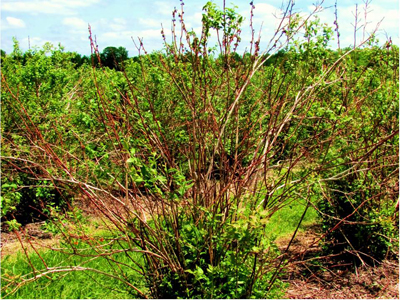West central Michigan small fruit regional report – June 4, 2015
Managing blueberry insects and diseases at winter-damaged blueberry fields can lead to difficult decisions.

This week we have seen a large emergence of cranberry fruitworm overwintering adults in Allegan and Van Buren counties. Given the current weather condition in west Michigan, we may find already the first eggs in blueberry fields around the Pullman-Grand Junction, Michigan, area. At other locations around west central Michigan, eggs could be found within the next two or three days (see table below).
Growers with fields that have a history of cherry fruitworm damage that applied the first insecticide spray against this pest early this week may require a second application seven days after to cover the cherry fruitworm oviposition period. If no cherry fruitworms were detected or the population was relatively small (two to three adults per trap per week), and the insecticide application was delayed until cranberry fruitworm emergence, then now is the time to spray for both insects. Since bees should already be out of the field, growers have a wider range of insecticide choices, including Imidan, Lannate and pyrethroid insecticides.
Please check the “2015 Michigan Fruit Management Guide” (E0154) from Michigan State University Extension for recommended insecticides and pesticide resistance management information.
Predicted degree days for appearance of overwintering fruit adults and first eggs | |||||
|---|---|---|---|---|---|
|
Insect |
First adults |
Second eggs |
Current degree day accumulation (6/4/2015) | ||
|
Grand Junction |
Fennville |
West Olive | |||
|
Cherry fruitworm |
238 ± 30 |
432 ± 15 |
575 |
454 |
473 |
|
Cranberry fruitworm |
375 ± 20 |
460 ± 20 |
575 |
454 |
473 |
In addition to insect pests, cane diseases are affecting many blueberry fields that suffered extensive damage during the past winter. A farm tour conducted during the past week and at the beginning of this week showed extensive cane collapse that is killing up to 80 percent or more of the plant structure (sees photos). Preliminary observations by our plant pathologist indicate Phomopsis is the main disease responsible for this problem. However, plant samples sent for laboratory analysis will provide concrete evidences about the identity of the pathogen responsible for this problem. Cane collapse is extensive around the Pullman-Grand Junction, Michigan, area, but most affected fields are those with varieties like Berkeley, Burlington and Jersey. The problem is less severe in Bluecrop fields or fields that suffered no significant winter damage.

Blueberry plant with extensive cane collapse.
We are also finding the cold 2015 spring is promoting the appearance of shoestring virus in fields and plants already infected. So, in addition to cane collapse, old varieties like Burlington and Jersey are showing intense symptoms of shoestring virus infection which affect entire plant rows. Affected plants have few or no fruit at all resulting from winter damage and virus infection.
Most growers already completed the early season fungicide spray program against mummy berry and Phomopsis twig blight and canker. However, only after the temperatures rose above the 70s and the vegetative growth started did the whole extent of the combine effect of winter damage and Phomopsis was obvious when the cane collapse started.
Now that it is evident there is not a commercial fruit crop in severely affected fields, the question is how to manage those fields. The answer is not simple. Besides a field without a commercial crop, we have fields that will produce a regular crop. For disease management, there are only a few options: renovate the entire field or extensively prune infected plants, and protect new growth against further cane disease infections. For insect pests like cherry fruitworms and cranberry fruitworms, the answer may be not to spray with the same intensity and limit insecticide applications to reduce the fruitworm populations to levels that may not create problems in adjacent fields. However, the situation could become more complex by the time we start spotted wing Drosophila (SWD) control. Unattended fields with few fruits will create the perfect breeding ground for large populations of SWD that will create substantial problems for growers in adjacent fields.
The diagnostic of the current situation indicates it is a concerted effort on the part of the blueberry industry and MSU Extension to overcome the challenges of the 2015 blueberry season before the season progresses too far.
Spotted wing Drosophila training update
We will be offering the first SWD training session June 15 at the Board Room in the Ottawa County Fillmore Complex in West Olive, MI. It includes a classroom and hands-on session focusing on understanding how the insecticide performs under a variety of weather conditions so growers and IPM practitioners can make informed decisions about when and how to utilize each one of the recommended insecticides. The program also emphasizes the use of MSU Enviro-weather to schedule your insecticide applications and select the best products or tools, depending on the current weather forecast.
There is a $30 registration fee that covers materials and refreshment. Gowers attending this workshop will receive four RUPs. To register online and view the event flyer, go to the 2015 Spotted Wing Drosophila Workshop Event page.
For assistance or more information on any of the topics presented here, contact your MSU Extension county office or contact me at 616-260-0671 or garcias4@msu.edu.



 Print
Print Email
Email


